
Castle Coeffin is a ruin on the island of Lismore, an island in Loch Linnhe, in Argyll, on the west coast of Scotland. It stands on a promontory on the north-west coast of the island, across Loch Linnhe from Glensanda, at grid reference NM853437 .

Castle Coeffin is a ruin on the island of Lismore, an island in Loch Linnhe, in Argyll, on the west coast of Scotland. It stands on a promontory on the north-west coast of the island, across Loch Linnhe from Glensanda, at grid reference NM853437 .
Coeffin Castle was built on the site of a Viking fortress.[ citation needed ] The name Coeffin is thought to come from Caifen who was a Danish prince, [1] and whose sister supposedly haunted the castle until her remains were taken back to be buried beside her lover in Norway.[ citation needed ]
Coeffin Castle was built in the 13th century, probably by the MacDougalls of Lorn. Lismore was an important site within their lordship, being the location of St. Moluag's Cathedral, seat of the Bishop of Argyll. The first written evidence of the castle occurs in 1469–70, when it was granted to Sir Colin Campbell of Glenorchy by Colin Campbell, 1st Earl of Argyll. It is unlikely to have been occupied in post-mediaeval times. [2]
The ruins comprise an oblong hall-house and an irregularly shaped bailey. The great hall is an irregular rectangle, measuring 20.3 by 10.4 metres (67 by 34 ft) The walls are from 2.1 to 2.4 metres (6 ft 11 in to 7 ft 10 in) thick. The bailey was mostly built at a later date than the hall. An external stair probably linked the entrance, in the north-east wall, to the bailey. A second door gave access to the sea to the south-west. [2]
A tidal fish trap, of unknown age, is located in the small bay to the south-east of the castle. [3] To the north-east of the castle are the remains of a stone-walled fort. [4] The Ordnance Gazetteer of Scotland, published in 1892, lists a Castle Rachal in the same general location as Castle Coeffin. It is described as "a very ancient Scandinavian fortalice in Lismore and Appin parish, Argyllshire, on the NW side of Lismore island, 4 kilometres (2.5 mi) from the north-eastern extremity, now a dilapidated ivy-clad ruin." [5]
Lismore is an island of some 2,351 hectares in the Inner Hebrides of Scotland. The climate is damp and mild, with over 166 centimetres (65 in) of rain recorded annually. This fertile, low-lying island was once a major centre of Celtic Christianity, with a 6th-century monastery associated with Saint Moluag, and later became the seat of the medieval Bishop of Argyll. There are numerous ruined structures, including a broch and two 13th-century castles.

Argyll, sometimes called Argyllshire, is a historic county and registration county of western Scotland.

Cowal is a rugged peninsula in Argyll and Bute, on the west coast of Scotland. It is connected to the mainland to the north, and is bounded by Loch Fyne to the west, by Loch Long and the Firth of Clyde to the east, and by the Kyles of Bute to the south.
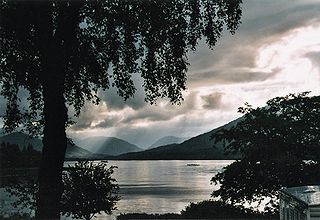
Loch Linnhe is a sea loch on the west coast of Scotland. The part upstream of Corran is known in Gaelic as An Linne Dhubh, and downstream as An Linne Sheileach. The name Linnhe is derived from the Gaelic word linne, meaning "pool".

Kilchurn Castle is a ruined structure on a rocky peninsula at the northeastern end of Loch Awe, in Argyll and Bute, Scotland. It was first constructed in the mid-15th century as the base of the Campbells of Glenorchy, who extended both the castle and their territory in the area over the next 150 years. After the Campbells became Earls of Breadalbane and moved to Taymouth Castle, Kilchurn fell out of use and was in ruins by 1770. It is now in the care of Historic Environment Scotland and is open to the public in summer.

Appin is a coastal district of the Scottish West Highlands bounded to the west by Loch Linnhe, to the south by Loch Creran, to the east by the districts of Benderloch and Lorne, and to the north by Loch Leven. It lies northeast to southwest, and measures 23 by 11 kilometres. The name, meaning "abbey land", in reference to Lismore Abbey, is derived from the Middle Irish apdaine.

Dunstaffnage Castle is a partially ruined castle in Argyll and Bute, western Scotland. It lies 3 miles (5 km) NNE of Oban, situated on a platform of conglomerate rock on a promontory at the south-west of the entrance to Loch Etive, and is surrounded on three sides by the sea. The castle and the nearby chapel ruin have been a Historic Scotland property since 1958. Both are Scheduled Ancient Monuments.

Achanduin Castle,, is a castle, now in ruins, located about 5.0 kilometres (3.1 mi) west of Achnacroish on the north-western coastline of the island of Lismore, in Argyll and Bute, Scotland. The castle overlooks Loch Linnhe and Bernera Island. The ruins are thought to date back to the thirteenth century. Achanduin Castle had long been thought to have been built by the Bishop of Argyll, though recent research has proved this to be unlikely. The castle was likely built by the MacDougalls around 1290 who held it throughout the fourteenth century. The castle was also thought to have been held by the Bishops of Argyll until the mid sixteenth century. It is a scheduled ancient monument.

Carrick Castle is a 14th-century tower house on the west shore of Loch Goil on the Cowal peninsula in Argyll and Bute, Scotland. It is located between Cuilmuich and Carrick, 4 miles (6.4 km) south of Lochgoilhead.
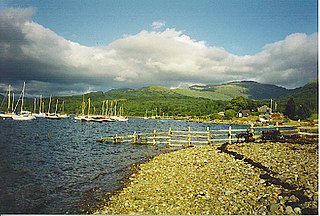
Barcaldine is a small settlement in Scotland centred on the historic Barcaldine House and located on the banks of Loch Creran between Oban and Ballachulish.

Faslane Castle and Shandon Castle were two mediaeval Scottish castles which once stood between the village of Garelochhead and the town of Helensburgh, near the shores of the Gareloch, in Argyll and Bute. In the 19th century, the castles were thought to have dated back to the Middle Ages. At that time period, they were situated in within the mormaerdom of Lennox, which was controlled by the mormaers of Lennox. Today nothing remains of Faslane Castle; though in the 19th century certain ruins of Shandon Castle were said to have still existed. Near the site of Faslane Castle sits the ruinous St Michael's Chapel, which has also been thought to date to the Middle Ages.
Auchenbreck Castle is located in Argyll and Bute, Scotland. Its remains are situated in Kilmodan parish, near the south of Glendaruel, 9 kilometres (5.6 mi) north of Tighnabruaich on the Cowal peninsula. Little remains of the castle, other than a flat rectangular platform, around 35 by 18 metres, between Auchenbreck farmhouse and the Auchenbreck Burn. This is partially bounded by a revetment wall up to 2.2 metres high.

Innes Chonnel Castle or Ardchonnel Castle is a ruined 13th-century castle on Innis Chonnell, an island on Loch Awe near Dalavich, Argyll and Bute, Scotland. The fortress was once a stronghold of Clan Campbell.

Minard Castle is a 19th-century castellated mansion on the north-western shore of Loch Fyne Argyll and Bute, on the west coast of Scotland, in the parish of Kilmichael Glassary.
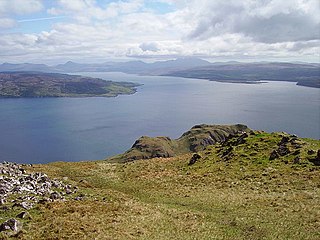
The Sound of Mull is a sound between the Inner Hebridean island of Mull and mainland Scotland. It forms part of the Atlantic Ocean.
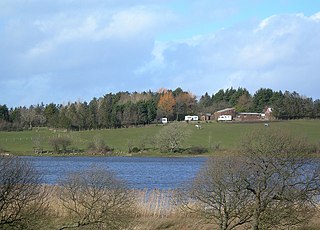
Martnaham Loch is a freshwater loch lying across the border between East and South Ayrshire Council Areas, two kilometres from Coylton, in the parishes of Coylton and Dalrymple, three miles from Ayr. The loch lies along an axis from northeast to southwest. The remains of a castle lie on a possibly artificial islet within the loch. The Campbells of Loudoun once held the lands, followed by the Kennedys of Cassillis.
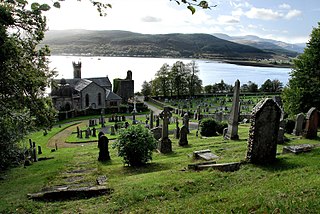
Kilmun Parish Church and Argyll Mausoleum in Kilmun, Argyll and Bute, Scotland, consists of St Munn's Church, as well as the adjacent mausoleum of the Dukes of Argyll and a historically significant churchyard. The complex is located on the summit of a slight knoll about ten metres from the shoreline of the Holy Loch on the Cowal Peninsula in Argyll, Scotland. The existing church dates from 1841 and occupies the site of an older, medieval church. A partly ruined tower from the medieval period still stands to the west of the present building.
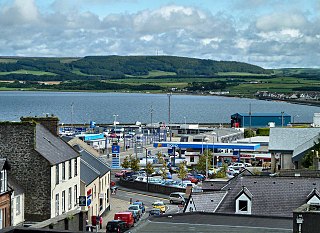
Inch is a civil parish in Dumfries and Galloway, southwest Scotland. It lies on the shore of Loch Ryan, in the traditional county of Wigtownshire.
Old Luce is a civil parish in Dumfries and Galloway, Scotland. It lies in the Machars peninsula, in the traditional county of Wigtownshire. The parish is around 10 miles (16 km) long and 8 miles (13 km) broad, and contains 40,350 acres (16,330 ha).
{{cite book}}: |author= has generic name (help)56°32′10″N5°29′36″W / 56.53612°N 5.49331°W